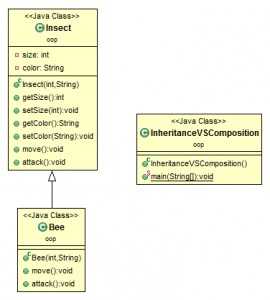标签:
原文链接:http://www.importnew.com/12907.html
本文主要说明Java中继承与组合的概念,以及它们之间的联系与区别。首先文章会给出一小段代码示例,用于展示到底什么是继承。然后演示如何通过“组合”来改进这种继承的设计机制。最后总结这两者的应用场景,即到底应该选择继承还是组合。
假设我们有一个名为Insect(昆虫)的类,这个类包含两个方法:1)移动move(); 2)攻击attack()。
代码如下:
|
1
2
3
4
5
6
7
8
9
10
11
12
13
14
15
16
17
18
19
20
21
22
23
24
25
26
27
28
29
30
31
32
33
34
|
class Insect { private int size; private String color; public Insect(int size, String color) { this.size = size; this.color = color; } public int getSize() { return size; } public void setSize(int size) { this.size = size; } public String getColor() { return color; } public void setColor(String color) { this.color = color; } public void move() { System.out.println("Move"); } public void attack() { move(); //假设昆虫在攻击前必须要先移动一次 System.out.println("Attack"); }} |
现在,你想要定义一个名为Bee(蜜蜂)的类。Bee(蜜蜂)是Insect(昆虫)的一种,但实现了不同于Insect(昆虫)的attack()和move方法。这时候我们可以用继承的设计机制来实现Bee类,就像下面的代码一样:
|
1
2
3
4
5
6
7
8
9
10
11
12
13
14
|
class Bee extends Insect { public Bee(int size, String color) { super(size, color); } public void move() { System.out.println("Fly"); } public void attack() { move(); super.attack(); }} |
|
1
2
3
4
5
6
|
public class InheritanceVSComposition { public static void main(String[] args) { Insect i = new Bee(1, "red"); i.attack(); }} |
InheritanceVSComposition作为一个测试类,在其main方法中生成了一个Bee类的实例,并赋值给Insect类型的引用变量 i。所以调用i的attack方法时,对应的是Bee类实例的attack方法,也就是调用了Bee类的attack方法。
类的继承结构图如下,非常简单:

输出:
|
1
2
3
|
FlyFlyAttack |
Fly被打印了两次,也就是说move方法被调用了两次。但按理来讲,move方法只应当被调用一次,因为无论是昆虫还是蜜蜂,一次攻击前只移动一次。
问题出在子类(即Bee类)的attack方法的重载代码中,也就是super.attack()这一句。因为在父类(即Insect类)中,调用 attack方法时会先调用move方法,所以当子类(Bee)调用super.attack()时,相当于也同时调用了被重载的move方法(注意是子 类被重载的move方法,而不是父类的move方法)。
为了解决这个问题,我们可以采取以下办法:
|
1
2
3
4
|
public void attack() { move(); System.out.println("Attack");} |
这样保证了结果的正确性,因为子类的attack方法不再依赖于父类。但是,子类attack方法的代码与父类产生了重复(重复的attack方法会使得很多事情变得复杂,不仅仅是多打印了一条输出语句)。所以第二种办法也不行,它不符合软件工程中关于重用的思想。
如此看来,继承机制是有缺点的:子类依赖于父类的实现细节,如果父类产生了变更,子类的后果将不堪设想。
在上面的例子中,可以用组合的机制来替代继承。我们先看一下运用组合如何实现。
attack这一功能不再是一个方法,而是被抽象为一个接口。
|
1
2
3
4
|
interface Attack { public void move(); public void attack();} |
通过对Attack接口的实现,就可以在实现类当中定义不同类型的attack。
|
1
2
3
4
5
6
7
8
9
10
11
12
13
14
15
16
17
18
19
20
|
class AttackImpl implements Attack { private String move; private String attack; public AttackImpl(String move, String attack) { this.move = move; this.attack = attack; } @Override public void move() { System.out.println(move); } @Override public void attack() { move(); System.out.println(attack); }} |
因为attack功能已经被抽象为一个接口,所以Insect类不再需要有attack方法。
|
1
2
3
4
5
6
7
8
9
10
11
12
13
14
15
16
17
18
19
20
21
22
23
24
25
|
class Insect { private int size; private String color; public Insect(int size, String color) { this.size = size; this.color = color; } public int getSize() { return size; } public void setSize(int size) { this.size = size; } public String getColor() { return color; } public void setColor(String color) { this.color = color; }} |
Bee类一种Insect类,它具有attack的功能,所以它实现了attack接口:
|
1
2
3
4
5
6
7
8
9
10
11
12
13
14
15
16
17
|
// 这个封装类封装了一个Attack类型的对象class Bee extends Insect implements Attack { private Attack attack; public Bee(int size, String color, Attack attack) { super(size, color); this.attack = attack; } public void move() { attack.move(); } public void attack() { attack.attack(); }} |
测试类代码,将AttackImpl的实例作为Attack类型的参数传给Bee类的构造函数:
|
1
2
3
4
5
6
7
8
9
10
11
12
|
public class InheritanceVSComposition2 { public static void main(String[] args) { Bee a = new Bee(1, "black", new AttackImpl("fly", "move")); a.attack(); // if you need another implementation of move() // there is no need to change Insect, we can quickly use new method to attack Bee b = new Bee(1, "black", new AttackImpl("fly", "sting")); b.attack(); }} |
|
1
2
3
4
|
flymoveflysting |
以下两条原则说明了应该如何选择继承与组合:
总结来说,继承和组合都有他们的用处。只有充分理解各对象和功能之间的关系,才能充分发挥这两种机制各自的优点。
参考:
标签:
原文地址:http://www.cnblogs.com/androidstudy/p/5504582.html